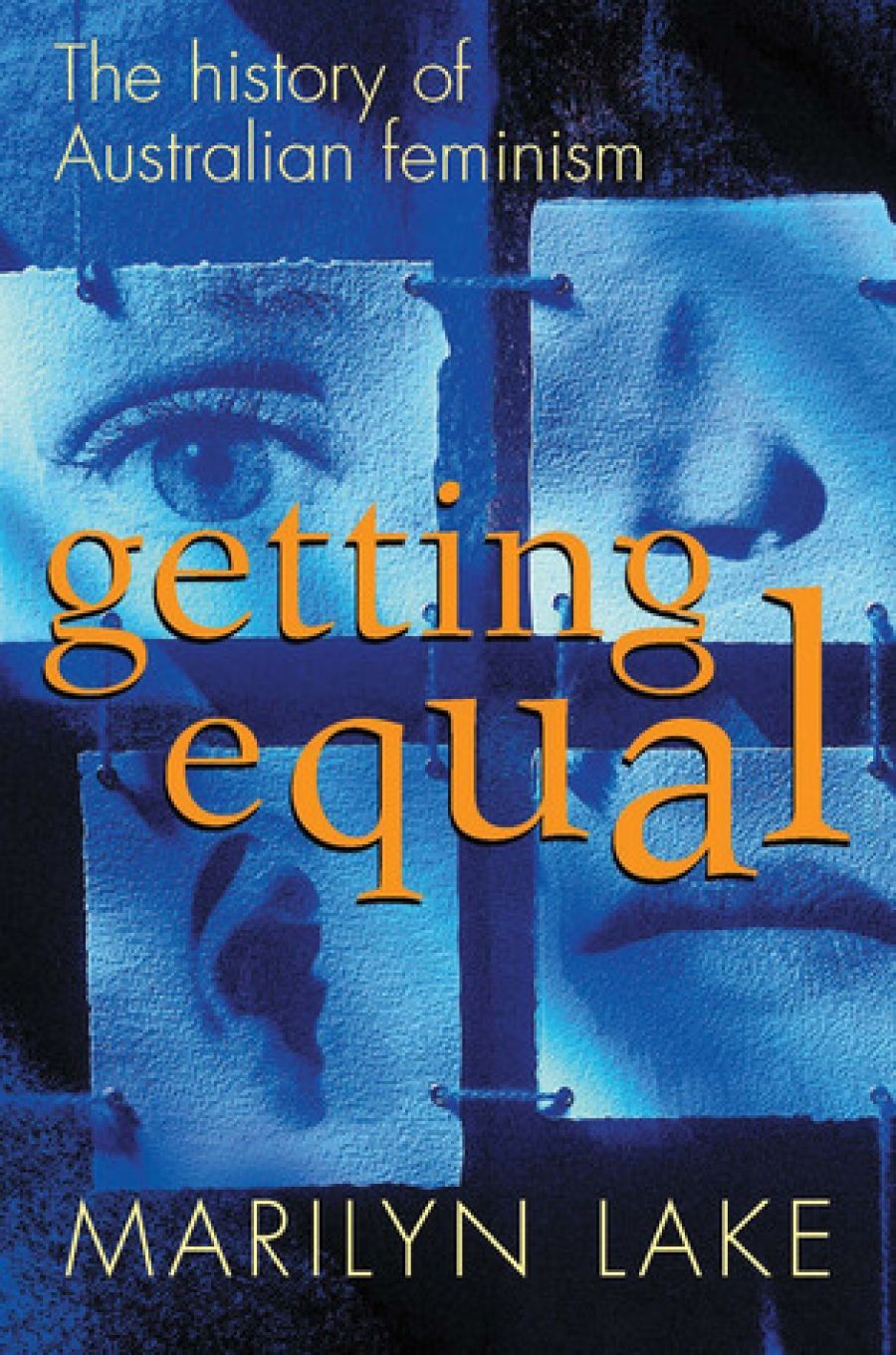
- Free Article: No
- Contents Category: Feminism
- Review Article: Yes
- Online Only: No
- Custom Highlight Text:
Getting Equal: The History of Australian Feminism sets out to cover the history of feminism in Australia during the period between 1877, when Charlotte Elizabeth McNeilly unsuccessfully petitioned the Sydney court for a divorce from her abusive husband, and now when Helen Osland is currently serving a gaol sentence for the murder of her husband after a married life of brutal abuse.
- Book 1 Title: Getting Equal
- Book 1 Subtitle: The history of Australian feminism
- Book 1 Biblio: Allen & Unwin, $24.95 pb, 304 pp
Rather than adopting a thematic approach or a strictly chronological one – either would have been appropriate in a short work designed as a handy textbook – Lake’s narrative of Australian feminism unfolds through a roll call of major figures, organisations and events. Lake wants to recuperate the names of feminists she claims have been lost to history –Henrietta Dugdale, Rose Scott, Bessie Harrison Lee, Louisa Lawson, Vida Goldstein, and others in the nineteenth century; Linda Littlejohn, Millicent Preston Stanley, Bessie Rischbieth, Ada Bromham, Jessie Street, Edith Cowan, Alice Henry and more between the wars; and many familiar names from the 1960s and 1970s who, surely, would not claim to have been forgotten. Lake’s argument is, presumably, that many of these names have been lost to popular culture or political history rather than feminist history.
Part 1 ‘Woman in a New World’ and Part 2 ‘Building a Woman-Friendly Commonwealth’ which deal with last century and the interwar period are the strongest sections. Lake offers a narrative that identifies maternalism – motherhood in relation to citizenship – as an active cause of the welfare state in Australia between the wars and thus challenges traditional accounts of the development of the state and its welfare apparatuses, including the fight by mothers for custody over their children. The critical edge is the argument for economic independence for married women: as long as married women were economically tied to men, they were no more than sexual slaves, compromised by their need to care for their children. Lake’s narrative traces the connections between contemporary mores (‘sexual freedom meant degradation for women’) and the development of a feminist critique of economic power, moral values (‘men must learn self-control and thus become more like women’) and citizenship (‘women are the mothers of the nation’). There’s some illuminating detail about the opposition of men to this feminist project. Quotations from men on the Left objecting to long running (from 1913) feminist demands for equal pay clearly show that economic independence for married women posed a serious threat to the power relations working in the traditional family unit. Asserting their rights as breadwinners and patriarchs, trade unionists conveniently forgot that working class women, for instance, have always worked; that, given the structure of the labour market, women were not taking men’s jobs; that women have always headed the majority of single parent families; that women combine childrearing with work. For John Newton, in 1924, economic independence for women was ‘claptrap’. Some traditions die hard. This is presumably a reason why, after winning formal acceptance of equal pay in 1969, Australian women still earn less than the average male full-time wage – as the NSW Pay Equity Inquiry has recently confirmed.
There are three basic problems with Getting Equal and the first is its definitive claim to being ‘the history of Australian feminism’. At any time, such a claim would be rash or implausible or both but at 304 pages, including notes, this history by a single author looks simplistic and partial compared with, for example, Australian Feminism A Companion, 584 pages, edited by Barbara Caine, Moira Gatens, Emma Grahame, Jan Larbalestier, Sophie Watson, and Elizabeth Webby – to which Lake contributed. Getting Equal is, actually, a revisionist history which attempts to recover a central position for middle class white feminism. There’s nothing wrong with this partiality – any history is partial – especially since Lake presents a detailed account of names, dates and events to document her narrative. But this is not the definitive history of Australian feminism because, as Gisela Kaplan and others have argued, there is no definitive history of Australian feminism. There is no single Australian feminism.
Second, Lake’s enthusiasm in covering the whole sweep of white women’s history in Australia means there’s no scope for debate and little analysis in her treatment. This is a more serious problem because Lake devotes significant space and weight to an account of the championing of rights for Aboriginal women by middle class white women. While Lake is careful to acknowledge the criticisms of white feminism by Pat O’Shane, Marcia Langton and others she offers no real analysis of, for example, the systemic paternalism of the campaign to save Aboriginal women from ‘falling into the hands of men’.
Third, Lake’s history dries up when the going gets tough at the end of the 1980s. The last decade has seen a backlash against feminism – of all kinds – right across the public domain. Lake’s consideration of the feminism of young Australian women is drastically reductive. ‘In its latest DIY mode, (feminism seems to have given away politics completely, announcing its project as one of “attitude” and “individual practice”.’ This kind of sneering simply confirms the worst of tabloid generationalism. One might well ask what kind of leadership feminists of Lake’s generation showed in the nineties when it was fashionable to pitch into young women from the safety of the Op.Ed. pages of national newspapers. Given her allegiance to the lessons of history, Lake might have asked why, after twenty-five years of Women’s Studies courses, institutionalised feminism in Australia apparently failed to produce young women sufficiently trained and confident to take feminism through the backlash and on to its next phase?


Comments powered by CComment